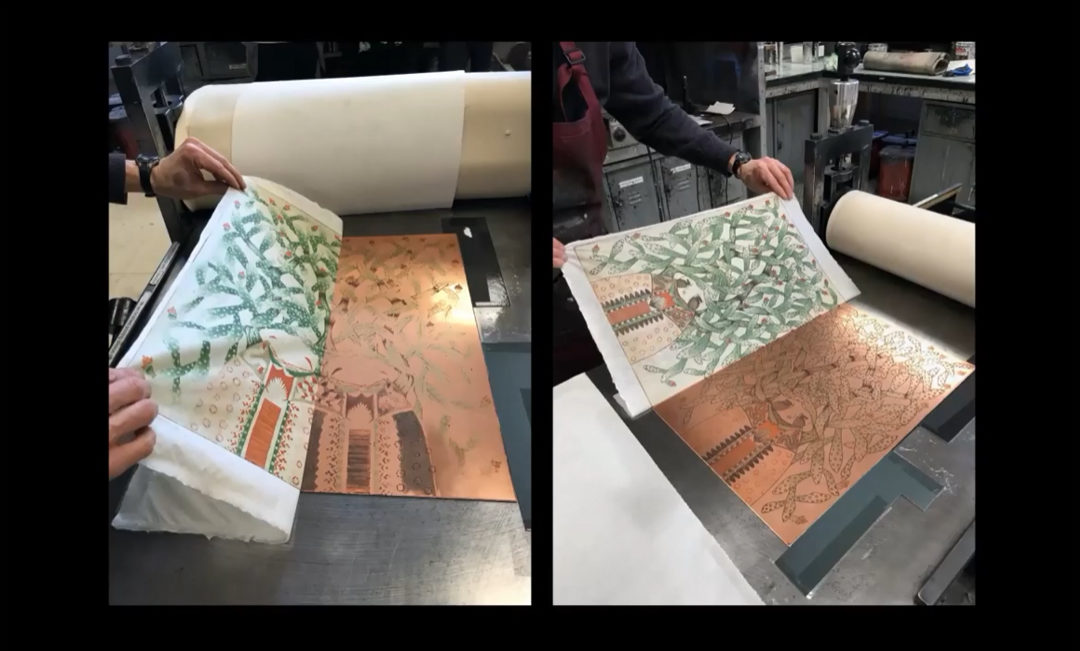Guest blog post by Paige Booth
“Off the Walls, Into Your Home: A Print Collecting Primer”
A Curated Conversation hosted by the Blanton Museum during PrintAustin 2021
Panel Speakers: Annalise Gratovich, artist, Blanton Museum paper preparator, PrintAustin board member
Pepe Coronado, artist, founder of Coronado Printstudio, PrintAustin board member
Genevra Higginson, artist admirer, Blanton Museum prints and drawings curatorial assistant
Held in conjunction with the Blanton’s printmaking exhibition entitled Off the Walls: Gifts from Professor
John A. Robertson.
Against the background of one UT professor’s lifetime collection of prints, two accomplished printmakers and a museum expert talked about the techniques and terminology of printmaking and how to cultivate your own interests when collecting prints.
Things to Know
Printmaking is a collaborative and communal process. Printmaking presses are large and expensive, so artists often go to a communal studio, engaging the artisans and experts there to print their finished work. When you enjoy a print, you are looking at the work of many hands.
The location of the studio and its ethos influences the kind of artists that are drawn to the studio to make work. According to Pepe Coronado, there is often a free flow of intellectual and political conversation as the artists and technical experts come together to accomplish the manual work, experimentation, and quality assurance of the printmaking process.
Many artists use printmaking as a way to comment on social issues. Because prints can be made in multiples and transported around a city or around the globe, there are examples throughout history of printmaking as a force in democratic (or revolutionary) processes and social movements.
A Few Terms
Fine art prints are original works of art, made in multiples. They are not reproductions.
The edition is the total number of prints the artist has committed to making.
The impression is the print itself.
If you see a handwritten notation at the bottom of a print that says “2/25” you know that you are looking at the second print of a maximum total of 25 that the artist will make.
Trial proofs or artist’s proofs are impressions made before the edition while the artist is experimenting with colors and papers to determine the ideal materials. These proofs are sometimes sold as well.
The chop is the identifying mark of the studio where the print was made. It is part of the provenance of the work and reflects the collaboration between the artist and the printmaking studio.
Annalise Gratovich recommends Pine|Copper|Lime as a resource for learning more about contemporary printmaking. This team, based in Bangkok, Thailand, hosts a popular weekly podcast and a robust social media presence to celebrate printmaking and its culture. [Editor’s note: Pine|Copper|Lime is now called “Hello, Print Friend!” and the team is in the process of moving back to the United States]
On Collecting
“Once you drink the Kool-Aid you are fully hooked,” says Genevra Higginson
John Robertson was a law professor and life-long collector who educated himself about printmaking by developing relationships with artists and curators. Cultivating friendships with printmakers whose work you enjoy can open the door for you to collect prints as soon as they are published, perhaps before an artist becomes well known and prices increase.
There are many ways to approach the collecting of prints. The easiest is to let your curiosity be your guide. Are you drawn to a particular technique, such as woodcut or silkscreen? Look for artists who are working in those techniques. Are you interested in a certain period of history? Head to museums and galleries to learn about artists from the past. Do you gravitate towards art with a message? Collect prints that were made by activist printmakers.
When it comes time to hang your prints in your home or office, frame them carefully to preserve and protect them. Printmakers thoughtfully select the paper they use, and it is considered an integral part of the art. It is customary to see prints framed in a manner that lets you see the whole sheet of paper, including the beautiful deckle edge of the paper, the artist’s signature, and the studio’s chop.
Then consider grouping your art in ways that integrate visual themes or messages. In this way, your prints can foster communal conversations with your friends, family, and colleagues for years to come!
The featured image in this post is an etching by Annalise Gratovich.









































